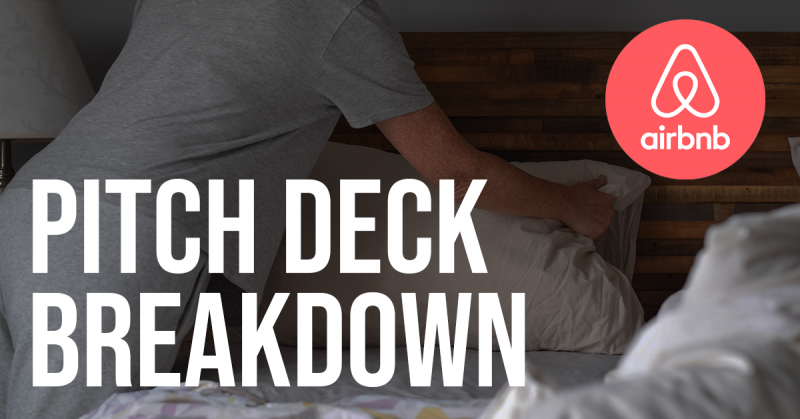To most experts, the “Airbnb pitch deck” is the crown jewel of startup presentations. It has everything investors look for and thousands of startups look to this deck as an example to emulate. If you’re seeking investors for your startup, Airbnb’s pitch deck can provide invaluable insights on how to excite and convince investors.
Pitch decks are essential for businesses in the fundraising process, especially when introducing investors to your brand and products. They play a pivotal role in telling your brand story and building excitement. While having a remarkable business idea is crucial, articulating its potential to investors can make or break your fundraising efforts.
Airbnb’s founders didn’t enter the market with fundraising experience. Still, in 2009, they crafted an extraordinary pitch deck that helped them raise an impressive $600,000 during their seed round.
In this article, we’ll meticulously analyze every aspect of the Airbnb pitch deck and uncover the secrets behind its powerful impact. By learning from this outstanding example, you can optimize your own pitch deck and maximize investor engagements for your startup.

About the Airbnb Pitch Deck
Before evaluating Airbnb’s pitch deck slides, let’s put the company’s situation into perspective. Airbnb is now a massive business, with millions of hosts and renters worldwide. However, the company didn’t begin with immediate success. Instead, the company’s humble beginnings started with an unexpected minimum viable product (MVP).
The company officially hit the market in 2008 but launched three times before attracting property owners and travelers across the nation.
The first launch was its minimum viable product. Before building an app, the team tested the market by offering airbeds for rent in the founder’s apartment. To validate its hypotheses, the team targeted travelers flying into California for a local conference. The team put the offer online, and three conference attendees immediately accepted.
Through this experiment, the company validated the customer problem. For travelers, hotels are expensive and don’t provide unique experiences.
After proving the concept, the founders created the initial website. The second version of the technology-enabled travelers to book a room in a renter’s home. After this launch, the team hit the fundraising trail, intending to raise $150,000 at a $1.5 million valuation.
CEO Brian Chesky said:
“We were introduced to 15 angel investors. 7 investors never responded, 8 replied – of those, 4 said no ‘it didn’t fit within their thesis,’ 1 said they didn’t like the market, and 3 just passed.”
Airbnb launched a third time at South by Southwest (SXSW), a festival that draws over 100,000 attendees each year. This final launch established the foundation for what would eventually become a unicorn startup.
By the time Airbnb reached the seed round, it already had traction, a website, and a proven business model. As a result of Airbnb’s pitch deck and positioning, the team raised $600K from Sequoia Capital.
Slide 1: Title

The vast majority of pitch decks start with a title slide that includes the brand name, logo, and slogan. Airbnb used a minimal design in its title slide, using its brand colors and grey text over a white background. Unlike many brands, Airbnb’s team chose not to include many design elements, like a background or images.
By leveraging this minimal theme, Airbnb’s logo stands out against the backdrop. The reader’s focus immediately goes to the most important elements, including the brand name and slogan.
The brand name alone brings intrigue and sparks curiosity. Separately, we know what air beds are and we are familiar with the Bed & Breakfast concept. But no one at the time could describe the relationship between the two. Readers would have to hold on to their seats and wait for the presentation if they wanted to gain clarity.
The appeal of the slide is that it leaves the reader curious. In 2008, booking with locals instead of hotels was an unfamiliar concept. Yet, the idea of merging the short-term housing industry with the sharing economy was intriguing.
When the team pitched this slide, audience members wanted to hear more about it. Even those who didn’t want to invest wanted to satisfy their curiosity. With only a logo and seven words, Airbnb successfully captured investors’ attention.
Slide 2: Problem

The Airbnb team decided to present its Problem Slide immediately in its pitch deck. Likewise, you should also consider placing this slide as one of the first in your startup presentation.
Successful businesses are those that solve massive problems for a vast number of customers. Investors are fully aware that if the problem isn’t large enough, then the solution doesn’t matter.
The Airbnb pitch deck makes the reader or audience aware of three massive problems among travelers. First, they mention that online bookings are too expensive for travelers booking online. Furthermore, hotels lack unique experiences and travelers don’t have a way to book rooms with locals rather than hotels.
The founders didn’t waste multiple slides explaining the problem. All they needed was three bullet points to expose the market’s challenges. In 2008, prior to Airbnb’s launch, any occasional traveler could relate to these challenges. Even today, hotel prices peak when there is an event drawing thousands of travelers to a particular city.
Airbnb proved that even a few bullet points can have a massive impact. They didn’t write in full sentences but presented each problem as a short sentence fragment. The audience can scan the slide for a few seconds and understand exactly what problem the startup is hoping to solve.
When creating your Problem Slide, focus on connecting the audience to the problem in a way they can quickly relate to. The audience should understand the market challenges even if they don’t experience them firsthand.
Slide 3: Solution
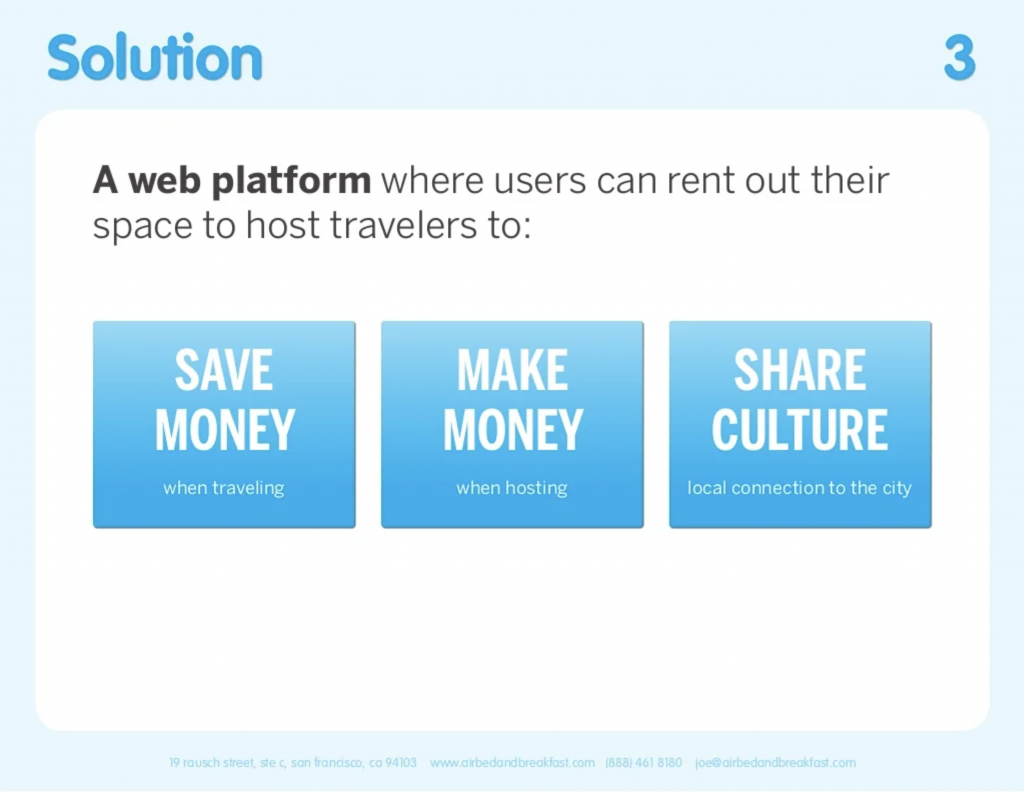
The Airbnb founders immediately followed the Problem Slide with the Solution. Following the same theme throughout the deck, this slide does not leverage extensive design. By minimizing design features, each element on the slide becomes more profound. The slide uses bold and capital letters to make the most important text stand out.
Notice that this slide refrains from explaining the features of the Airbnb solution. Instead, they focused on showcasing the benefits of the platform. Ultimately, customers don’t care about your product or what features it provides. They only care about how it can benefit them, improve their situation, or better their lives.
The slide emphasizes the following words: a web platform, save money, make money, and share culture. Without reading it word-for-word, the audience quickly grasps that it is a web platform that provides three significant benefits.
Your pitch deck may or may not adopt Airbnb’s minimal design approach. However, you should also focus on the benefits of the solution as opposed to its features. Instead of explaining every feature offered, detail how your solution directly solves the issues from the Problem Slide.
Slide 4: Market Validation
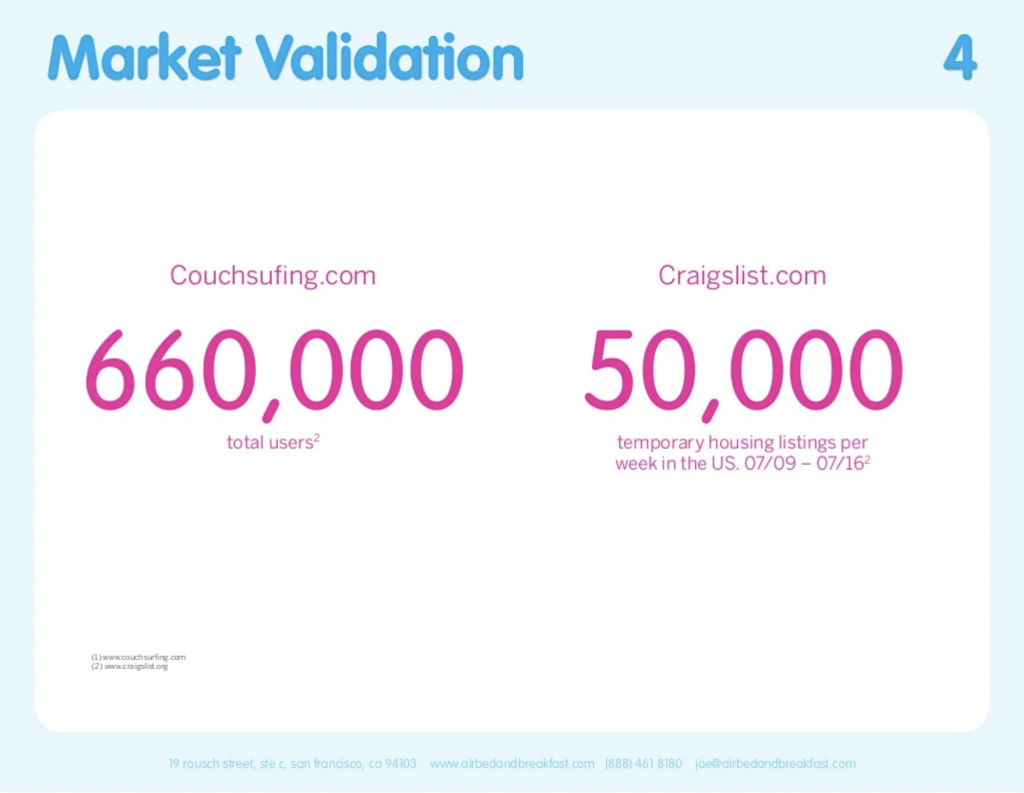
Airbnb had some traction, but the founders only served three customers during its MVP launch. While that may seem impressive to some, it isn’t a strong enough metric to sway investors.
The founders refrained from showing Airbnb’s minimal traction. Instead, they showcased the market size by detailing the number of temporary housing listings on sites like CouchSurfing and Craigslist. This approach was risky but worth it. By showing statistics from other platforms, the pitch deck validates that real consumers are in the market seeking a suitable solution.
In this slide, Airbnb’s founders focused on simplicity and proof. There are no complex graphs, no distracting images, and very limited text. In this slide, the focus is on the elements that stand out the most, the market validation numbers.
Slide 5: Market Size
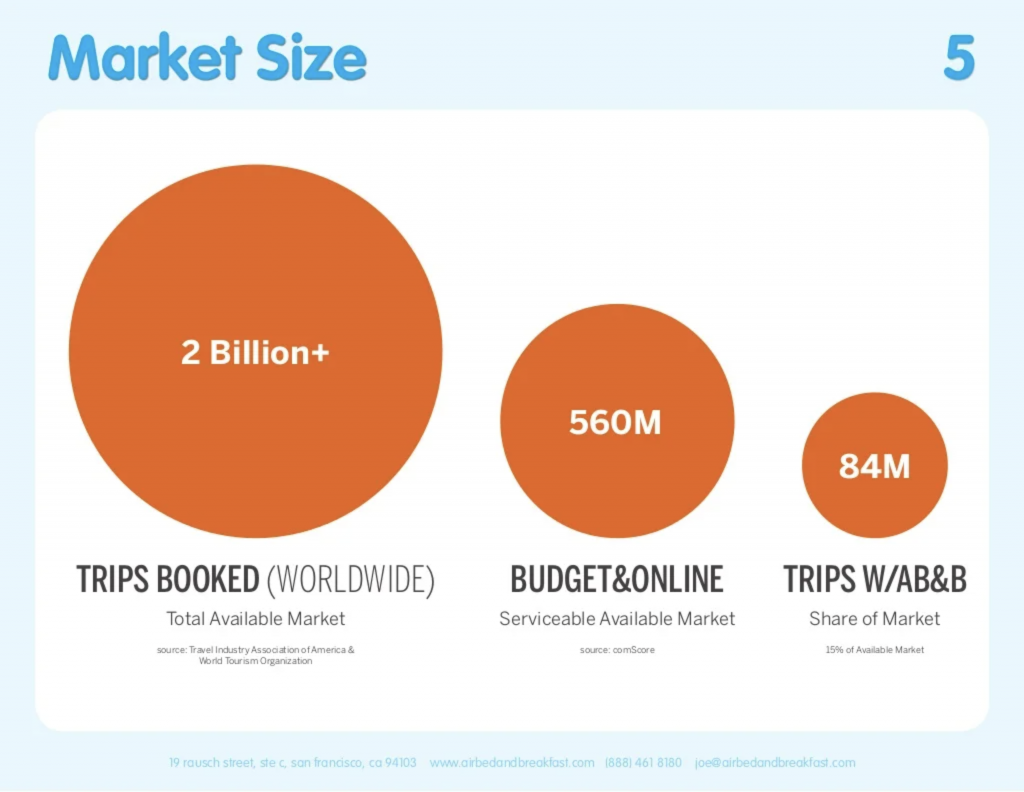
The Market Size slide utilizes a framework called the TAM, SAM, and SOM target market analysis. Many startups use this framework and investors are quite familiar with it. This analysis enables startups to showcase the total size of their markets compared to the percentage they can likely attract.
For the Total Available Market, the Airbnb pitch deck detailed the number of trips booked worldwide. Any traveler could potentially be a future Airbnb customer.
However, the company doesn’t attract every type of traveler with its solution. Instead, Airbnb focuses on individuals seeking to travel on a budget and those actively booking trips online. When the team created its pitch deck, 560 million individuals fit this description.
Finally, the team expressed the market share they believed the company could acquire – 84 million customers. The Serviceable Obtainable Market looks at competition and the startup’s ability to secure a meaningful position. Then, it analyzes what portion of the SAM the startup could potentially capture.
Slide 6: Product

Airbnb’s Product Slide successfully fulfills two objectives. First, it showcases the company’s web platform with three images, making investors fully aware of its features. It also proves how simple it is for users to book a property – search by city, review listings, and book it.
The team could have decided to explain its payment system and the intricate details of its browse/search engine. However, these additions would have muddied the slide and made the process seem complex. Instead, Airbnb wanted to showcase the simplicity of its platform – and the Product Slide achieves this goal.
Slide 7: Business Model
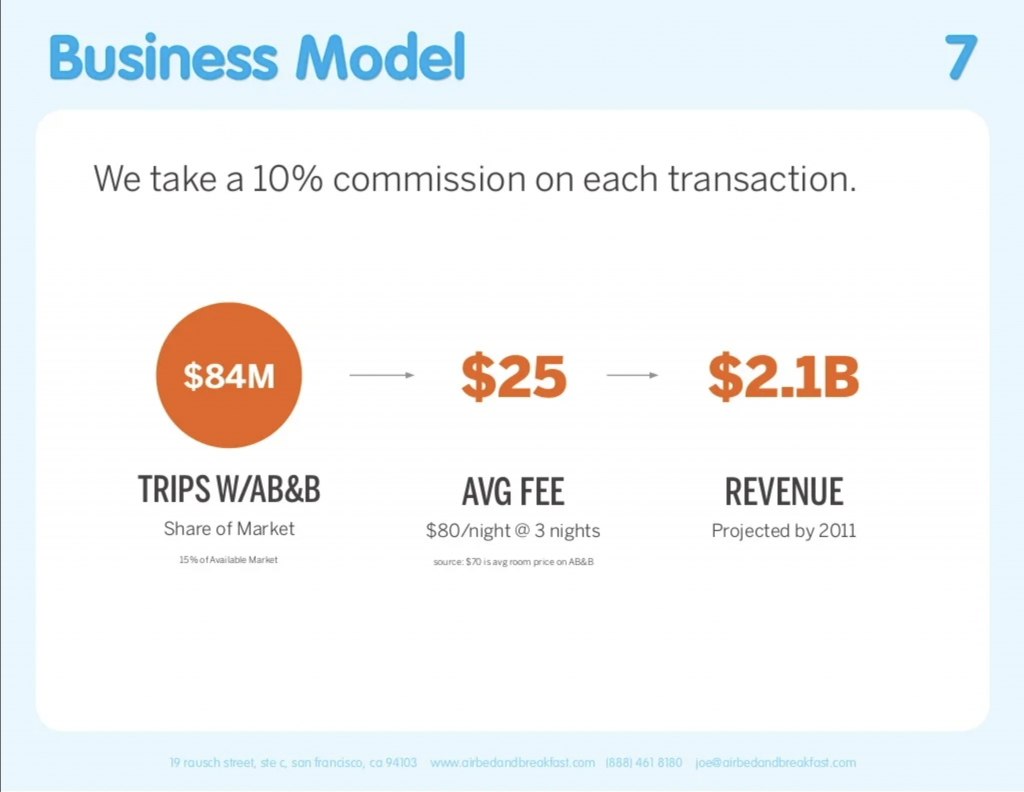
Investors want to know about market sizes and problems. But always remember that they are investors, not activists. Their primary goal is to make money, not save the world.
There is one question every investor will ask – how do you earn revenue? Investors want to earn a return on their investment, which is impossible if the business cannot turn a profit.
The Airbnb pitch deck defines its revenue model with a short statement, “We take a 10% commission on each transaction.” Furthermore, it showcases a single business model and defines the company’s expected revenue by its third year.
Don’t expect investors to do complex calculations to estimate the financial potential of your startup. Follow Airbnb’s lead and model it in a way that they can immediately understand.
Slide 8: Adoption Strategy

Airbnb’s Market Adoption Slide used imagery to explain its strategy for attracting new customers. The three channels include events, partnerships, and a Craigslist dual posting feature.
Customer acquisition is critical to a startup’s success. This slide shouldn’t just provide a long list of marketing strategies. Instead, consider how you will introduce your product to customers who have never heard of your company. Furthermore, consider your budget and how you can leverage it to attract early adopters.
Slide 9: Competition
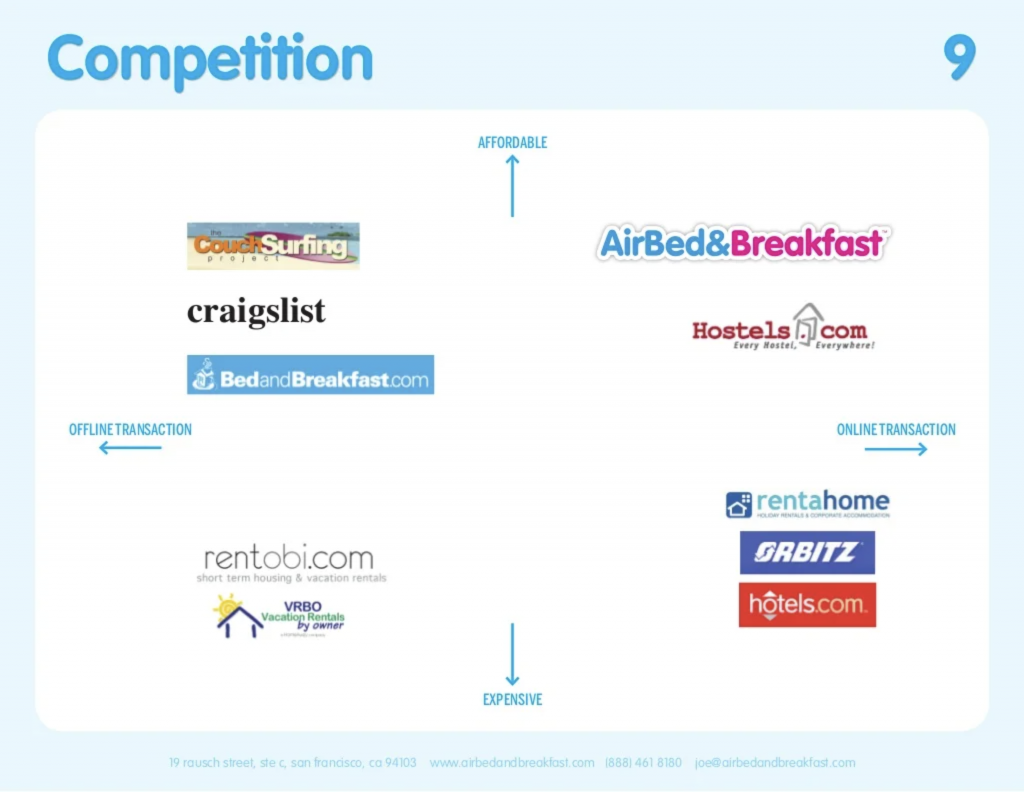
The Competition Slide explains the startup’s market position as it relates to competitors offering a similar solution. Most startups add a Competitor Feature Table to this slide. In the table, they list each competitor and use checkmarks to compare each brand’s features, offerings, and qualities.
However, Airbnb designed its Competition slide differently. It used a matrix with Offline vs. Online Transactions on the X-axis and Affordable vs. Expensive on the Y-axis. This approach positions Airbnb as an affordable online provider and separates its offering from competitors placed in other rows and columns.
Slide 10: Competitive Advantage

In the previous slide, Airbnb showcased its closest competitors and mapped out its position in the competitive landscape. In the Competitive Advantages Slide, the deck showcases how Airbnb outperforms similar existing solutions.
The slide uses six frames to emphasize Airbnb’s advantages. Despite having more text than previous slides, the clean design makes it simple to understand.
Slide 11: Team

There is nothing especially unique about Airbnb’s team slide, but it includes all the information an investor requires. The slide provides a short bio of each founder, comprising an image, their positions, and a detailed but short description.
Furthermore, the slide mentions the company’s advisors. Investors look for solid teams with the experiences needed to build and scale a successful startup. Investors feel more comfortable when teams have advisors to provide advice in areas where founders lack experience.
Slide 12: Press

By adding a Press Slide, Airbnb added credibility to its pitch deck and business concept. Since media sources seek out interesting stories, a new concept like Airbnb received massive coverage. In exchange for providing journalists with a great story, the media provided Airbnb with significant brand awareness across its markets.
In this slide, the founders showcased logos from different sources and added relevant quotes from the articles.
Slide 13: User Testimonials
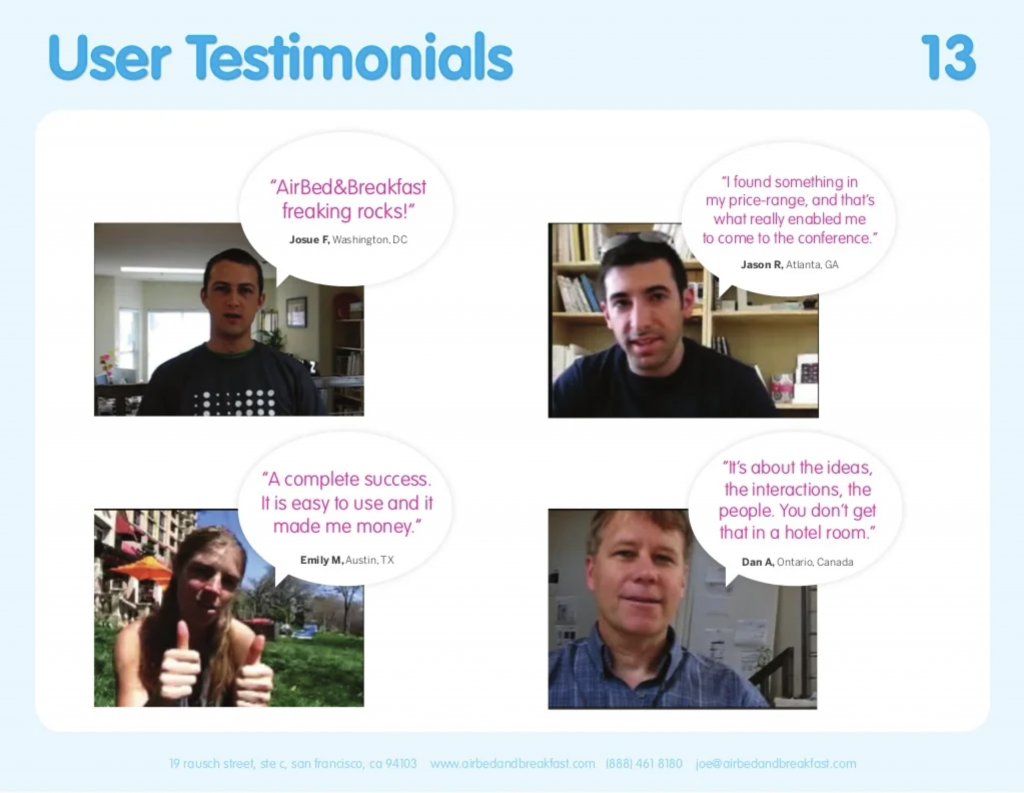
User testimonials serve as a form of validation, giving investors confidence that the solution fulfills customers’ needs. Furthermore, they validate the company’s claims by providing evidence that the product meets its claims.
The Airbnb pitch deck uses personalization to make its user testimonials more impactful. They added real pictures, not headshots, so the audience knows it’s a real person. In addition to photos, they included a bubble with the user’s actual feedback.
Slide 14: Financials

In many pitch decks, startups showcase a separate Financials Slide and Capital Ask Slide. The pitch deck for Airbnb combines these slides. It showcases the investment opportunity on the left and financial projections on the right.
Too often, startups load the financials slide with complex graphs and tables. Yet, Airbnb’s design enabled the team to show how much they were raising and provide a 12-month projection. The Airbnb pitch deck makes it clear that less explanation can be more impactful than too much information.
Learn THIS About the Airbnb Pitch Deck
Startups seeking to approach investors to raise funds should study the Airbnb pitch deck template closely. The pitch deck was effective because it told a story using very few words. It utilized visuals and minimal design to hone in on the most important information. If you follow the pitch deck structures of successful startups like Airbnb, you may be able to replicate their success, too!
For more pitch deck examples, take a look at the following video. In this video, we evaluate slides from several of the world’s best pitch decks.




